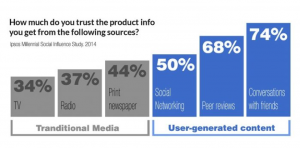Content marketing has matured and I’ve committed to learning more about it this summer. We’ve passed the phase of sharing brand generated content and developed to a model that is focused on data and analytics. As the backbone of a digital strategy, data puts the consumer preferences at the helm of today’s digitally strategy.
Even with a data-driven content strategy, the most sophisticated marketers are challenged with a task of producing authentic content that delivers quality content and highlights the brand in a unique non-brand driven narrative. Adding memes, GIF’s or having an Instagram account, isn’t sufficient. Neither is hiring some millennials to manage the newest social platforms.
Today’s consumers are digital natives. They want content that is valuable, personal, and focuses on their interests without the overt messages of a brand- centered campaign. With consumers extremely skeptical, marketing professionals confront a new marketing reality that forces them to reframe their marketing efforts.
 So how can a brand scale its content marketing efforts to meet the needs of today’s digitally minded consumer?
So how can a brand scale its content marketing efforts to meet the needs of today’s digitally minded consumer?
Digital marketers can shift their efforts to be customer-driven without diminishing their brands’ message. Brands simply have to be willing to get closer to the source– their customer. Marketers looking to engage with their consumers –the very reason the company exists – and find ways to bring their customers into the fold. How can digital marketing professionals turn customers into the primary source of their digital efforts?
The answer is that a brand needs to shift the content efforts by integrating user-generated content, or UGC for short, as their next powerful content marketing tool.
What is User Generated Content?
User generated content is where the brand and customer meet. It’s defined as any type of content that has been produced, promoted or created by customers. It tells brands how customers actually engage and use the product. UGC delivers the most trustworthy content without the brand interceding.
UGC Validates Your Offering with Voices of Your Customers
Not only does UGC enable the brand to solidify their positioning within their industry, but more importantly it provides a direct mode of conversation with their audience. By eliminating any potential barriers between brand and consumer, companies can reach a broader audience and connect with their marketing segments, something that many brands struggled with until recently.
Why is UGC such a powerful content marketing tool?
People trust people.
A recent survey by Stackla found that authenticity is more important than ever, especially in a world filled with celebrity endorsements, sponsored posts and paid influencers, consumers crave authenticity, now more than ever.
UGC Cuts through the Marketing Noise
Consumers consider user-generated content most authentic.
User-generated content isn’t only a way for brands to identify consumer interests, it’s actually increasing the bottom line. Consumer driven content actually drives others to purchase without any brand involvement.
According to the Stackla report, over half of the Millennials surveyed (a generation with a purchase power of over $200 billion) have made travel or other leisure plans based on user-generated content that was delivered in their social media feeds.
UGC is an effective at influencing purchasing decisions because consumers trust content that is generated by their peers over content generated by the brand itself. Several years ago, Burberry launched a user-generated campaign which yielded a 50% increase in online sales.
Of course, the positive (or negative) experiences are shared in real-time on social media, which in turn impacts future decisions. It’s precisely the constant stream of content that inspires others by instilling a sense of FOMO, which just perpetuates the ongoing cycle of user generated content and the ROI of social media.
Maximizing UGC and Outsmarting the Competition
After working with a diverse range of clients, from startups to the city of Jerusalem, I noticed that all were going about social content the same way –rather than leveraging their consumer content as a source – they tried too hard to create new content. Together, I guided them to augment or bolster existing content strategies with UGC as relatively easy way to outpace their competitors.
The benefits and opportunities of user-generated campaigns are clear and that’s exactly why 86% of brands have tried consumer driven campaigns. Once initiated, 70% of these brands, have found it easier to create on sustain new content marketing efforts. Collecting UGC can be as easy as asking for it. Chobani, the global Greek yogurt company, put their loyal consumers to the test and asked them to share the many reasons why they love the yogurt. The fans responded with tons of fresh, delicious content. Once Chobani collected it, the brand decided to maximize the user-generated content by sharing across all digital channels and integrating these images into traditional media and advertising campaigns. According to Chobani, their increase of nearly 226% in revenue can be attributed to the switch to UGC.
Several years ago, the city of Jerusalem’s tourism division decided to embark upon a similar campaign. By allowing the tourists, the city’s best advocates, to become the primary voice of social content. First, the city leveraged events that drew major international crowds (like the Jerusalem marathon), as a way to collect content from participants, with a simple hashtag. In three years since embracing UGC during the marathon, the city was able to increase its event-driven user content by 66% from 2015 to 2018, yielding a social reach of 3 million customers and now uses UGC as the primary source of its social campaigns.
What Does UGC and the shift mean for digital marketing?
As marketers, we’re constantly competing for our customers’ attention and wallets. We struggle to generate new, compelling and valuable content. But, as it turns out, we’re probably going about it all wrong. Our customers aren’t looking for choreographed images or stock photos to highlight the value of the product, they want to see other consumers using it. Customers want the raw, unique, and unadulterated content that is relatable and natural.
Marketers have to simply listen to our customers and give them what they want. With so much quality content being generated by consumers, we just have to tap into it and allow them to guide our digital and traditional campaigns.
Want to read about how others are staying up to date this summer? Check out these recent posts:
Family Picnics, Sun and Learning?
Author: Mordecai Holtz

Mordecai is an avid blogger and an active contributor to the digital marketing space. His content has been featured on industry leading sites including Social Media Today Business2Community, Social Media World and Post Planner, a leading social media platform with close to 1 million unique views a month. Mordecai has also been featured on DukoscopyTV a leading forex trading television channel.
Beyond his writing within the industry, Mordecai has submitted guest content to several tech blogs including Technologer and TechAcute. Mordecai has spoken at several conferences including IMTM, Israel’s leading Tourism Conference and MegaComm, a leading Israeli conference for technical writers, on the topic of User Generated Content and Turning Customers into Brand Ambassadors.


0 Comments